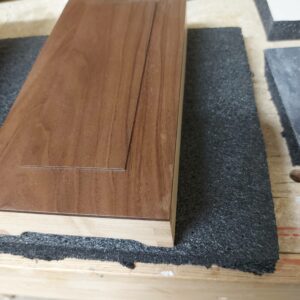Small light blemishes in new lacquer finish on walnut
Hi,
Wondering what is causing these light blemishes and how to fix it. I am using spray can lacquer (Watco satin lacquer) using the instructions. I have applied several light coats, and have tried sanding down this area prior to the next coat, but they remain. There is no glue in this area and I wiped down the wood with paint thinner prior to finishing.
















Replies
Knowing I was going to use lacquer, I would not have wiped it down with paint thinner. I would have used lacquer thinner or alcohol. However, I don't think that is the source of the problem unless the paint thinner was still wet when you applied the lacquer. It sure looks like glue smears. If not glue, it appears that something else has dropped or splashed on it that has sealed the pores preventing the lacquer from penetrating in those areas. I think the only fix it is to sand it or strip it back to bare wood and start over.
Thanks, the thinner was applied several days previously. The patches are only seen from certain angles and running my finger over the area feels nothing different.
I agree with bilyo; looks like glue...almost like fingerprints, accidental handling marks perhaps.
If not glue, maybe just oily fingertips. But sanding and refinishing might be the only fix.
I have had zombie finger prints show up a few times before. I'm positive it's always been from gluey hands. I've started being a LOT more diligent with glue on my hands and they've gone away.
That said, there was one time in my old musty basement shop that a few drops of sweat dropped onto a plywood panel. I saw it happen and didn't think anything of it at the time. Wiped on stain and there they were. I thought I would be able to "stain them out" with subsequent coats of stain or finish. Nope!
Now I'm wondering if zombies sweat.
I guess I will have to sand it out, which is a little difficult as the edges are all beveled, and I have to leave the join at the corners. Hopefully the issue does not go to deep. Since it's lacquer, I can just respray over the sanded and still finished areas.
Cardscraper might be more precise, get the offending spots before sanding to feather out the imperfections. It is disturbing to know that Ben is a zombie.
Walnut is one of the naturally-oilier woods. So, my 2 pennies worth says sand down to raw wood, rub thoroughly with acetone then cover with a couple coats of dewaxed shellac.
Truthfully, I learned that from something I read here on FW. Regardless, the acetone will dry out the surface enough to apply the shellac which will seal the oils in the wood. A good consequence is that lacquer will adhere nicely to shellac.
Mikaol
I like the cardscraper idea, I will try that initially.
I have scraped and sanded that section off, will let you know how it goes with the respray. I will also use acetone instead of paint thinner.
Will acetone damage the remaining/existing lacquer finish?
I believe it will. Nail polish is lacquer; nail polish remover is acetone.
yup, i just tested it on a scrap and it removed the lacquer. What solvent, if any, to use to clean up the corner before respraying?
This forum post is now archived. Commenting has been disabled